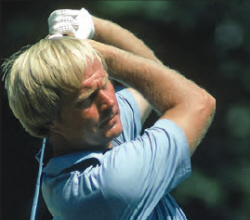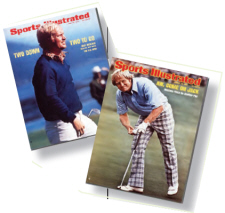Jack Nicklaus- Life’s Golden Bear
Mention the name Jack Nicklaus to a golfer, and so many different things come to mind: champion, architect, businessman, family man, and  statesman are just a few of the adjectives that would be appropriate.
statesman are just a few of the adjectives that would be appropriate.
When it came to winning, no other golfer in history, as of this writing, has won more major championships than Nicklaus’s total of 20, which includes two US Amateur titles. As an architect, his designs are among some of the best, including Muirfield Village, Castle Pines, and Shoal Creek.
Nicklaus was always the consummate family man, trying to never play more than two weeks in a row when his children were growing up. He and his wife, the former Barbara Bash, continue to have close relationships with their fi ve children: Jackie, Steve, Nan, Gary, and Michael. He is also the grandfather of 21.
Jack William Nicklaus was born January 21, 1940, in Columbus, Ohio, to parents Charlie and Helen. As a boy, Nicklaus took up the game at age 10, and shot a 51 for the first nine he ever played under the tutelage of Scioto Country Club head professional Jack Grout.
Improving rapidly, Nicklaus became a child prodigy not seen since the days of Bobby Jones, winning numerous championships. He won the Ohio State Junior Championship at age 12 for the first of five consecutive victories in that tournament. He qualified for the US Amateur at 15, and at age 16 he won the Ohio State Open against a field of top amateurs and professionals from around the state. A year later in 1957, he qualified for the first of his 44 consecutive US Open appearances, and in the fall he entered The Ohio State University. In 1958 at age 18, he played in his first PGA Tour event, the Rubber City Open, and was just one stroke out of the lead after 36 holes before finishing 12th.
In 1959, Nicklaus made his fi rst real splash on the national scene, winning the fi rst of his two US Amateur titles. A year later, he was a major factor in what many consider the greatest US Open of all time at Cherry Hills in Denver, Colorado. Playing the final 36 holes with the great Ben Hogan, Nicklaus finished in solo second place, two strokes behind Arnold Palmer. Hogan later famously remarked, “I played 36 holes today with a kid who should have won this thing by 10 shots,” in describing Nicklaus’s relative inexperience at the time.
 Nicklaus graduated from college in 1961 and went to work selling life insurance. As a fan of Jones, Nicklaus intended to follow in the great man’s footsteps and remain an amateur competitor. Ultimately, Nicklaus realized he wouldn’t be utilizing his greatest talent fully, and after a conversation with USGA executive director Joe Dey, he turned professional in November.
Nicklaus graduated from college in 1961 and went to work selling life insurance. As a fan of Jones, Nicklaus intended to follow in the great man’s footsteps and remain an amateur competitor. Ultimately, Nicklaus realized he wouldn’t be utilizing his greatest talent fully, and after a conversation with USGA executive director Joe Dey, he turned professional in November.
Nicklaus earned his first check as a professional at the 1962 Los Angeles Open at Rancho Park Golf Course, taking home the princely sum of $33.33. He played frequently during the fi rst part of the year, entering 16 tournaments prior to the US Open at Oakmont Country Club in Pennsylvania.
Palmer was the king of golf in 1962, having firmly established himself as the game’s number one player, as well as its most popular. Nicklaus, the reigning US Amateur champion, and Palmer, were paired together for the first two rounds of the Open. Palmer won the battle over the fi rst 36 holes, shooting a -3 score of 139 to tie for the lead with Bob Rosberg. Nicklaus was three strokes back at 142 in fourth place, tied with Bobby Nichols and Gary Player.
Accounts vary on how many times Palmer three-putted during regulation play, but a 1962 article indicated Palmer took seven, while Nicklaus had one. Perhaps it was fitting, then, that on the 72nd hole, Palmer’s 10-footer to win stayed on the high side, necessitating a playoff the next day.
Once again, Nicklaus’s putting was sharp and Palmer’s was not, and Nicklaus went on to win the playoff 71 to 74. It was his first professional victory, and of course, the first of 18 professional majors.
Player agent Mark McCormack gave Nicklaus his famous nickname in a magazine interview when he described him as a “golden bear.” By 1963, the nickname was permanently associated with Nicklaus.
Nicklaus’s dominance as a player was remarkable, not only in terms of winning majors, but in consistency. He finished in the top four of the PGA Tour’s money list for 17 consecutive years, from 1962 to 1978. In 1979, Nicklaus struggled with his game, didn’t win a tournament for the first time in his professional career, and finished 71st on the money list. Jack Grout noticed that Nicklaus had become too upright in his swing, so in the 1979-80 offseason they set about to remake Nicklaus’s swing to be rounder and flatter.
After also enlisting the services of short-game guru Phil Rogers, Nicklaus had a stellar 1980, winning the US Open and PGA Championship. He would go on to win three more times in his PGA Tour career, including the historic 1986 Masters.
Nicklaus’s interest in golf course architecture was whetted in the 1960s, when Pete Dye asked Nicklaus for his opinion on Dye’s new course, The Golf Club, in suburban Colombus. Nicklaus’s first design, a co-design with Dye, was the highly acclaimed Harbour Town Golf Links in Hilton Head, South Carolina. Since then, he has designed more than 300 courses worldwide, and his design work keeps him traveling the globe. Also working in his golf course architecture firm are sons Jackie, Steve, Gary, and Michael, and son-in-law Bill O’Leary, who is married to Nicklaus’s daughter Nan. Nicklaus, as a businessman, has also been very successful, not only in golf course architecture, but in other ventures including book author, clothing, golf academies, and equipment. Despite the higher profile of other equipment companies, Nicklaus Golf continues to hold its own in the marketplace.
As an author, Nicklaus’s 1974 book Golf My Way is an all-time classic, influencing countless golfers, among them Greg Norman, Ernie Els, K. J. Choi, John Daly, and Sean O’Hair. In addition, Nicklaus put out a video version of the book in 1983, and has written 12 others.
Nicklaus’s life hasn’t been completely without difficulties, of course. In the mid-1980s, Nicklaus Companies (then known as Golden Bear Golf), the umbrella from which all of his businesses operate, got overextended with debt after getting involved in some non-golf-related businesses, and was close to bankruptcy. With tighter management, the company was able to stave off bankruptcy and prosper.
In 1996, the Golden Bear company went public, but soon ran into difficulties. John R. Boyd and Christopher Curbello, who headed Golden Bear’s golf course construction subsidiary, Paragon Construction International, overstated the subsidiary’s revenues and contract profitability, which caused Golden Bear to file false and misleading financial statements for 1997 and the first quarter of 1998. In 2000, Golden Bear was taken private, and remains in the hands of Nicklaus and his family as Nicklaus Companies. In late 2003, Boyd and Curbello pleaded guilty to conspiracy to commit securities fraud.
Perhaps the greatest tragedy in Nicklaus’s life occurred in March 2005, when his 17-month-old grandson Jake, son of Steve, drowned in a hot tub after the family’s nanny lost track of the toddler. Nicklaus wasn’t sure he wanted to play in that year’s Masters, but with encouragement from Steve, he teed it up at Augusta National for what proved to be the final time in the major championship most associated with Nicklaus.
Later that year, he played in a tournament for the final time at St. Andrews in The Open Championship. As he had done so many times in his career, he birdied the final hole.
Today, a new generation of golfers and sports fans know Nicklaus as that guy whose majors record is being chased by Tiger Woods. Ultimately, we know Nicklaus is far more than just a historical competitor. His legacy, not only as a champion but also of sportsmanship and putting family first, is sure to be noted as long as the game is played.






